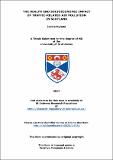Files in this item
The health and socioeconomic impact of traffic-related air pollution in Scotland
Item metadata
| dc.contributor.advisor | Donnelly, Peter | |
| dc.contributor.advisor | Inchley, Jo | |
| dc.contributor.author | Hyland, Jackie | |
| dc.coverage.spatial | 282 | en_US |
| dc.date.accessioned | 2017-09-25T09:21:06Z | |
| dc.date.available | 2017-09-25T09:21:06Z | |
| dc.date.issued | 2017-08-29 | |
| dc.identifier | uk.bl.ethos.725086 | |
| dc.identifier.uri | https://hdl.handle.net/10023/11734 | |
| dc.description.abstract | Traffic-related air pollution harms health, so whilst it would be advantageous to improve air quality, the socioeconomic impact of air pollution mitigation in Scotland is not fully understood. Evidence from research literature, current regulatory and policy directives and a socioeconomic analysis are required to assess the true health impact. This thesis presents the first health and socioeconomic analysis of traffic-related air pollution and health for Scotland. A critique of the literature was undertaken to determine the evidence base and the strength of evidence in terms of association and causation, between air pollution and ill health. The evidence was subsequently applied in epidemiological studies of Scottish residents, to assess the actual impact on health in Scotland. The perception of barriers and incentives for change were investigated to understand behavioural influences. Recent policy development in Scotland was reviewed, and a socioeconomic analysis of a proposed air pollution strategy in Scotland, was undertaken. The evidence from 30 cohort studies and nine literature reviews demonstrated a link between poor air quality, mortality and respiratory ill health, but the results for other health conditions were inconsistent. The links were associative rather than causal and therefore might be attributable to other factors other than air pollution. Furthermore, epidemiological studies on Scottish populations did not show health effects from traffic-related air pollution. The socioeconomic analysis suggested that an initial investment of between £27m and £44m to introduce Low Emission Zones (LEZ), and an effective active travel programme, might result in a saving of £38m in terms of Years of Life Lost (YLL) and reduction in sickness absence. It is unlikely that the Clean Air For Scotland Strategy will deliver improved air quality and health without substantial investment, better alignment of planning, and a greater public engagement to support public and active transport options. | en_US |
| dc.language.iso | en | en_US |
| dc.publisher | University of St Andrews | |
| dc.rights | Attribution-NonCommercial-NoDerivatives 4.0 International | * |
| dc.rights.uri | http://creativecommons.org/licenses/by-nc-nd/4.0/ | * |
| dc.subject | Air pollution | en_US |
| dc.subject | Traffic | en_US |
| dc.subject | Socioeconomic | en_US |
| dc.subject | Health impact | en_US |
| dc.subject | Scotland | en_US |
| dc.subject | Cleaner Air for Scotland Strategy | en_US |
| dc.subject | Cohort study literature review | en_US |
| dc.subject | Association or causality | en_US |
| dc.subject | Epidemiological studies | en_US |
| dc.subject | Air quality management areas | en_US |
| dc.subject | Policy development | en_US |
| dc.subject | Behaviour change | en_US |
| dc.subject.lcc | RA576.7S3H8 | |
| dc.subject.lcsh | Automobiles--Motors--Exhaust gas--Scotland--Health aspects | en |
| dc.subject.lcsh | Automobiles--Motors--Exhaust gas--Scotland--Social aspects | en |
| dc.subject.lcsh | Automobiles--Motors--Exhaust gas--Scotland--Economic aspects | en |
| dc.subject.lcsh | Air--Pollution--Scotland | en |
| dc.title | The health and socioeconomic impact of traffic-related air pollution in Scotland | en_US |
| dc.type | Thesis | en_US |
| dc.contributor.sponsor | NHS Tayside | en_US |
| dc.type.qualificationlevel | Doctoral | en_US |
| dc.type.qualificationname | MD Doctor of Medicine | en_US |
| dc.publisher.institution | The University of St Andrews | en_US |
| dc.publisher.department | NHS Tayside | en_US |
The following licence files are associated with this item:
This item appears in the following Collection(s)
Except where otherwise noted within the work, this item's licence for re-use is described as Attribution-NonCommercial-NoDerivatives 4.0 International
Items in the St Andrews Research Repository are protected by copyright, with all rights reserved, unless otherwise indicated.


